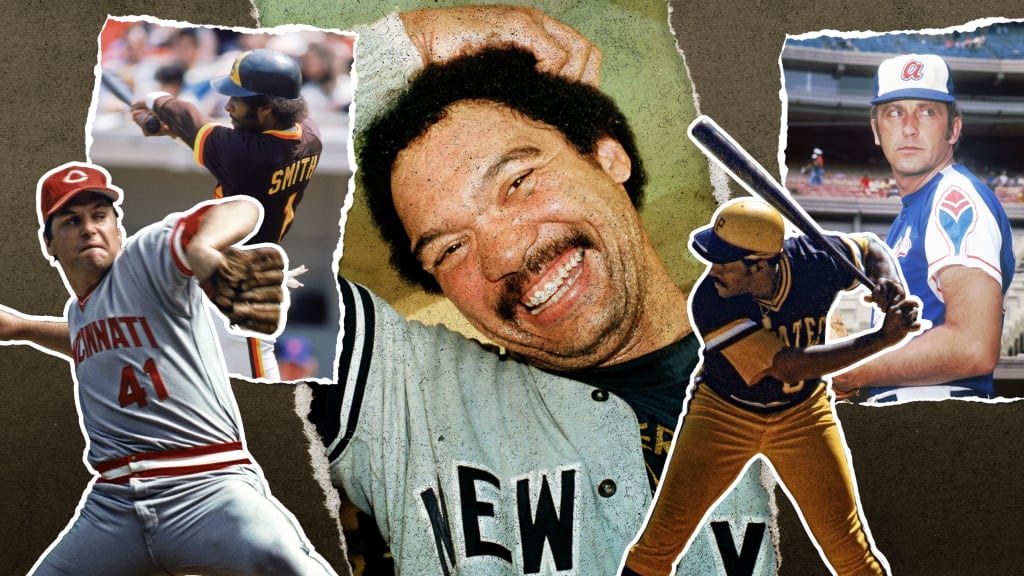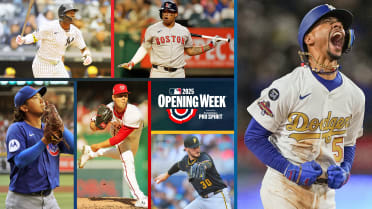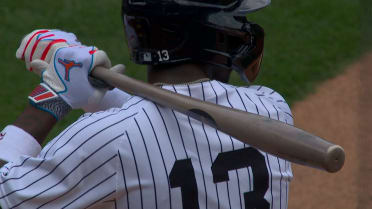
Throughout our hopefully short time without real live games, we’ll be taking a weekly look back at a specific year in baseball history. What happened, why it mattered, what we’ll remember most. Send us the years you’d most like us to talk about at will.leitch@mlb.com.
Year: 1978
LCS: Dodgers over Phillies in 4; Yankees over Royals in 4
World Series: Yankees over Dodgers in 6
MVPs: AL: Jim Rice, Red Sox; NL: Dave Parker, Pirates
Cy Youngs: AL: Ron Guidry, Yankees; NL: Gaylord Perry, Padres
Rookies of the Year: AL: Lou Whitaker, Tigers; NL: Bob Horner, Braves
All-MLB Team (chosen by me, in 2020):
1B: Rod Carew, Twins
2B: Willie Randolph, Yankees
SS: Roy Smalley, Twins
3B: Doug DeCinces, Angels
OF: Jim Rice, Red Sox
OF: Dave Parker, Pirates
OF: Amos Otis, Royals
C: Ted Simmons, Cardinals
DH: Rico Carty, Blue Jays/A’s
SP: Ron Guidry, Yankees
SP: Phil Niekro, Braves
SP: Mike Caldwell, Brewers
SP: Jim Palmer, Orioles
RP: Rollie Fingers, Brewers
RP: Rich Gossage, Yankees
I miss when the Yankees were fun. The Yankees have obviously long been good. They were good during their dynasty from 1996-2000, they were good even when the Red Sox at last ended the Yanks' dominion and they’re good now. But those are all “Pride of the Yankees” Yankees teams, the ones with an enduring myth of class and short haircuts and true Yankees that actually led to a real Broadway play called “Bronx Bombers” in which the Yankees greats were all characters and the guy who played George Washington in “Hamilton” played Derek Jeter. (For less than a month. The play didn’t last long.) Those are the Yankees who are clean cut, wholesome and legends. Those Yankees are great. But they are no fun.
No, my favorite Yankees teams are the ones that had three primary qualities:
1. They were messy and full of tabloid drama.
2. They were a little bit ornery.
3. They were also, yes, great.
We haven’t seen these Yankees in a long time. The 1980s were the Don Mattingly era, and he was a wonderful player, but the team didn’t win a World Series title -- or even a postseason series -- until he left. The late-'90s Yankees were dominant and inspiring, but also maybe, if you’re being honest, a little bit dull. The most fun Yankees teams were the teams of the late 1970s. Those are the Yankees I’ll always dream of. Always fighting, always in trouble, always causing some sort of havoc … and winning the whole dang thing anyway.
Here’s the first of many fun facts about the 1978 Yankees: They had four managers, and two of them were the same guy. In mid-July, with the team struggling (well, 47-42, which is struggling in The Bronx), manager Billy Martin ordered star Reggie Jackson (with whom he’d had a fight the year before, in the incredible season documented in the fantastic Jonathan Mahler book “The Bronx Is Burning”) to bunt.
After one failed bunt, Martin called the bunt off, but out of passive-aggressive fury, Jackson kept bunting anyway and eventually fouled out. Martin was so furious he suspended Jackson for five games, and when his suspension was over, he refused to play. Martin responded with a classic Billy Martin line, referring to Reggie and owner George Steinbrenner: “One’s a born liar, the other’s convicted.” This is never a smart thing to say about one’s best player and one’s employer. Martin “resigned” the next day, though everyone knew he was actually fired. Dick Howser (who would be smart enough to get out of town in a couple of years and go win a championship with the Royals) managed for one game (he lost), and then Bob Lemon took over for the rest of the year. But even that was fraught with drama. On Old Timer’s Day five days later, Martin (a former Yankees player of course) was introduced as “the manager of the team for the 1980 season.”
Yeah, the Yankees were wild. They had characters for sure, from Jackson to Martin to Goose Gossage to Catfish Hunter to Thurman Munson to Graig Nettles to Sparky Lyle to Lou Piniella. (Even Yogi Berra was one of the bench coaches.) They had an AL Cy Young Award-winning season from Ron Guidry, who won 25 games with a 1.74 ERA. But all that hadn’t added up to much by July 19, when the Yankees were 14 games behind the Red Sox in the AL East and all the Martin drama happened.
Then, though, the Yankees took off, narrowing Boston's lead to three games on Sept. 7, when the series that would become known as the Boston Massacre happened. The Yankees won four games in Fenway Park by a combined score of 42-9, erasing the deficit entirely. The teams played neck and neck the rest of the year, ending up tied and necessitating a tie-breaking 163rd game the day after the regular season ended.
That was the Bucky Dent game.
That Yankees team, with all its drama, was basically the equivalent of the 2004 Red Sox team: Forgotten and mocked … until it got its act together and vanquished its most hated rivals. The Yankees went on to breeze past the Royals in the AL Championship Series, and after two losses in the first two World Series games at Dodger Stadium, they won the next four to win the title. (The series still has the highest television ratings in the history of the World Series.)
The Yankees were fighting all the way to the end. Jackson spent most of the Series criticizing (eventual World Series MVP) Dent for distracting him while running on a pitch, and he kept hammering Martin throughout, too. It kept the papers very, very happy. There was so much to discuss. It was such a glorious mess.
The plot of that “Bronx Bombers” play involves Berra (played by Peter Scolari) trying to get Jackson and Martin to settle their feud in a hotel room and leads to Yogi talking to various stars in Yankees history, including Babe Ruth, Lou Gehrig, Joe DiMaggio, Mickey Mantle and Jeter. The whole idea of the play is that the Yankees are eternal, even when there is discord, like there was in 1977 and '78. But the play foregrounds the legends, and not the huge personalities and constant fighting of the late-'70s teams. It is thus boring and closed quickly. Like Broadway, the Yankees work best when there is drama.
There was no more drama than there was in 1978. And that Yankees championship -- their last until 1996 -- counts as much as the rest of them.
Here are 10 fun facts from the 1978 season.
1. The No. 1 overall Draft pick in 1978 was Bob Horner, an infielder out of Arizona State and a player widely considered one of the best in college baseball history. Horner went directly to the Majors without playing a game in the Minors, hitting a homer off Bert Blyleven only a few weeks after the Braves picked him. He hit 23 homers that year and won the NL Rookie of the Year Award, barely edging out Padres shortstop Ozzie Smith.
2. Oh, about Ozzie Smith. This was his rookie year, the first of four seasons he played for the Padres before being traded to the Cardinals for Garry Templeton after the 1981 season. Smith wasn’t much of a hitter at the time -- he hit one homer in 2,536 plate appearances for the Padres this rookie year -- but his defense was otherworldly. He arguably made the best defensive play of his entire illustrious career this season, when he grabbed a ground ball that took a bad hop with his bare hand. You really cannot watch it enough.
3. One more player drafted in 1978 that you’d end up hearing about: In the second round, the Orioles selected a legacy kid, Cal Ripken Jr., the son of the team’s third-base coach. Ripken was thought, by the Orioles and every other team that considered him, to be a pitcher; it was only the Orioles who decided to give him a shot at shortstop, his preferred position. He played 63 games of rookie ball in 1978.
4. There were two no-hitters in 1978. The first was thrown in the season’s first week by the Cardinals’ Bob Forsch, the first home no-hitter for that franchise since 1924. (He’d be the only Cardinals pitcher to throw a no-hitter for 21 years.) But the more memorable one was thrown by the Reds’ Tom Seaver, who had come so close to a no-hitter so many times in his career (including losing a perfect game in the ninth nine years earlier) before no-hitting the Cardinals in June. Seaver was calm about the achievement. “A no-hitter, it’s momentary,” he said, comparing it to winning a championship. “You enjoy the moment, that’s all.”
5. When Jim Rice was elected to the Hall of Fame in 2009, many statistically-oriented analysts argued that his numbers didn’t hold up under today’s standards. But in 1978, they absolutely did. Rice was an absolute monster in '78, leading the AL in homers (46), hits (213), RBIs (139), slugging percentage (.600), OPS (.970), total bases (406) and triples (15). He still didn’t walk much (58 times), but the way Rice hit that season, why would he want to? If Rice had hit every year like he did in '78 (or '79 or '83, for that matter), no one would ever argue against him for the Hall.
6. Another player who had a remarkable year -- and only got a sixth-place NL Cy Young finish for it -- was Atlanta’s Phil Niekro. It will make your arm hurt just looking at his stats in 1978. Niekro threw 22 complete games in 42 starts, with a 19-18 record in 334 1/3 innings. Sure, he was a knuckleballer, but c’mon. (He was also 39.) Here are his innings totals from 1977-79:
1977: 330 1/3
1978: 334 1/3
1979: 342
That’s 1,006 2/3 innings. That’s 95 fewer innings than Jacob deGrom has thrown his entire career so far. The 1978 season was actually the best of those years for Niekro. He had a 2.88 ERA, putting up a 10.4 Wins Above Replacement season (per Baseball-Reference) … which is basically Mike Trout’s 2018.
7. Did Willie Stargell really hit the ball 535 feet into the upper deck of Olympic Stadium on May 20? No one had ever hit a fair ball that far before, but 535 feet? If only we could retroactively apply Statcast. Don Sutton said Stargell “doesn't just hit pitchers, he takes away their dignity.” Still, we’ve never seen video of this, and neither have you.
8. One of the most promising young players of his time, one who developed a friendship and even a competitive rivalry with teammate Rod Carew, had his life and career cut short in 1978. Lyman Bostock, the son of a Negro Leagues star, had hit .336 with 14 homers, 12 triples and 16 steals for the Twins in '77, before signing as a free agent with the Angels prior to the '78 season. He got off to a slow start -- and felt so guilty about it that he offered to return his April salary and instead donated it to charity -- but he hit .404 in June and went 2-for-4 in his final game in Chicago in September, raising his average to .296. He then went to visit his uncle in nearby Gary, Ind., and was shot by a mentally ill man who believed Bostock was having an affair with his wife. (Bostock had just met the woman 20 minutes earlier.) At his funeral, teammate Ken Brett said, “We’re better people for having him touch our lives.”
9. Pete Rose, in what would be his final year with the Reds until he returned as player-manager seven years later, hit .302 and had a career-high 51 doubles. But his 1978 was far more historic than that. He knocked his 3,000th career hit, off Steve Rogers of the Expos in May, and, even more impressively, this was the year of his 44-game hitting streak, a streak that hasn’t been matched since. He also, sort of amazingly, didn’t have a single home run during the entire streak.
10. One baseball milestone this year: The Dodgers became the first team in baseball history to draw 3,000,000 fans in a season. In the 42 seasons since then, they’ve hit that number 32 times.
Send me the year you’d love to have me write about at will.leitch@mlb.com.




